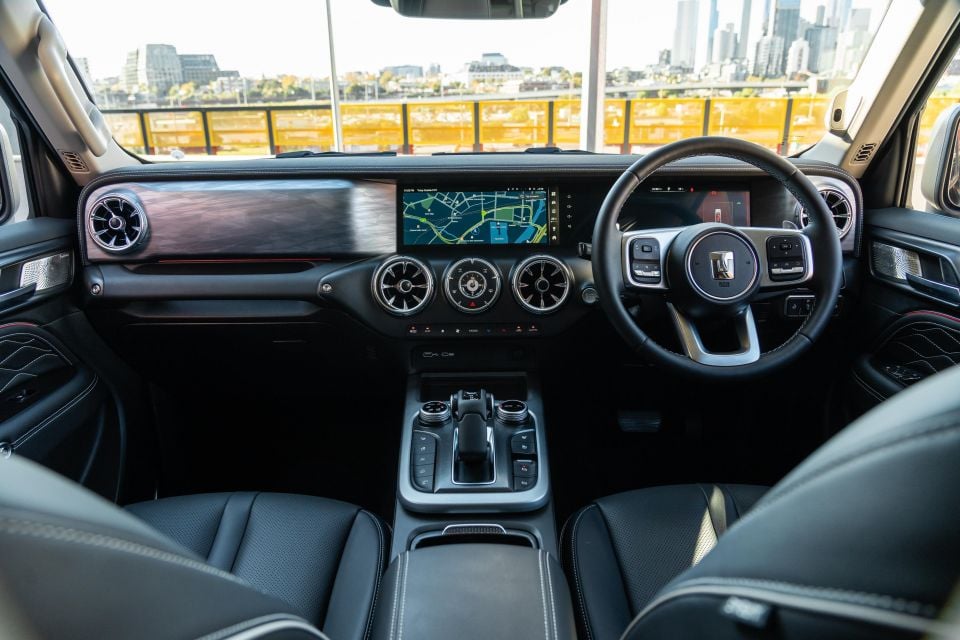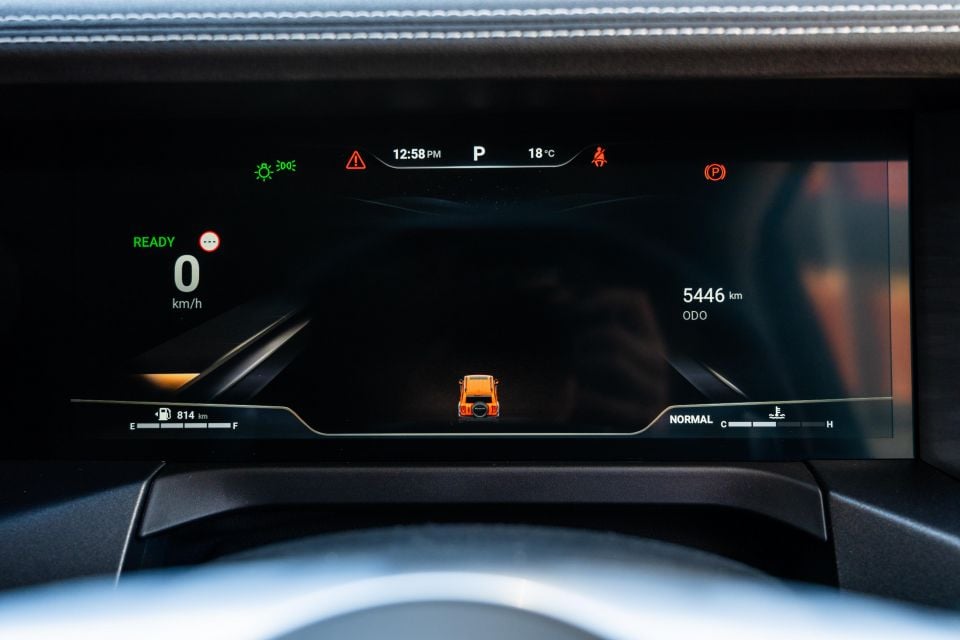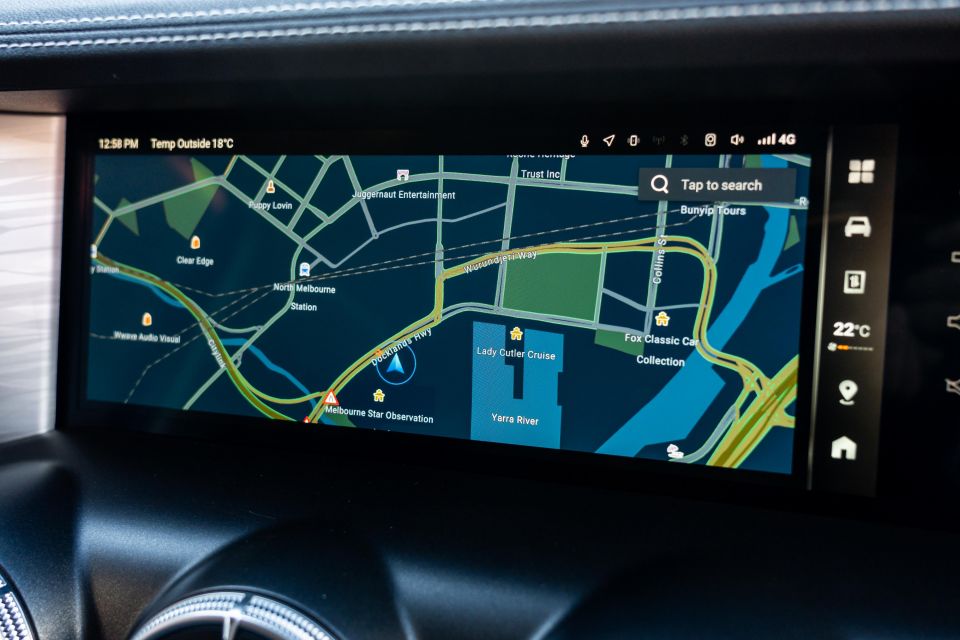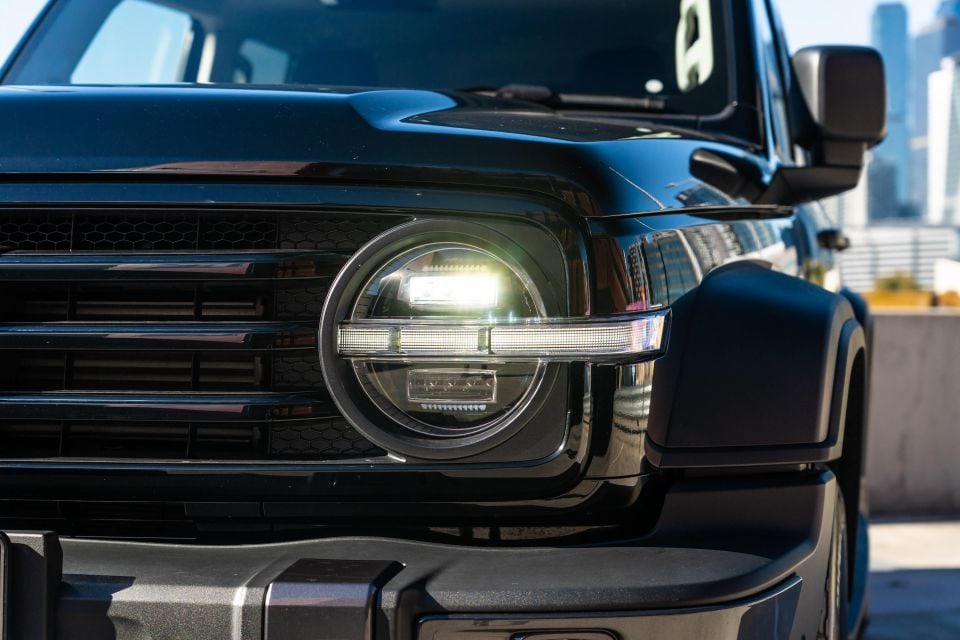

Damion Smy
GWM Cannon Alpha ute, Tank 300 HEV and Tank 500 recalled
13 Hours Ago
It brings a unique hybrid powertrain at a lower price than other large 4x4s, but is the Tank 300 the best Chinese off-roader available?



Quickly see how this car stacks up against its competition. Select any benchmark to see more details.
Where expert car reviews meet expert car buying – CarExpert gives you trusted advice, personalised service and real savings on your next new car.
GWM is not one to sit idly by, and the Tank 300 is a prime example of how an upstart carmaker can create waves in an automotive niche if it really wants to.

Take the offroad-ready Jeep Wrangler, combine it with the luxurious yet rugged Mercedes-Benz G-Class, add a dash of Suzuki Jimny, and you get something like this: the GWM Tank 300 Ultra Hybrid.
It’s striking in appearance and stands out on the road, and it’s still the only model in its segment to offer a hybrid drivetrain. That gives it impressive power and torque figures, so it’s no slouch in a straight line.
Our tester is the most expensive Tank 300 variant you can buy at more than $60,000 drive-away, but it undercuts a lot of its large off-road SUV competition without skimping on any infotainment or safety tech.
GWM armed nearly 2000 Australians with a Tank 300 in 2023, despite the fact it only arrived halfway through last year, and so far this year to October it has sold more than 3300 examples.
That’s much fewer than the Ford Everest (21,281), Isuzu MU-X (15,584) and Mitsubishi Pajero Sport (6367), but almost as many as the Toyota Prado in runout (3525).
WATCH: Paul’s video review of the GWM Tank 300 Ultra Hybrid
GWM is just one of many relatively new challenger brands making their way Down Under and local buyers are increasingly willing to make the jump.
Can the Tank 300 become the new vehicle of choice when it comes to more affordable, luxurious off-roading, or is it all too good to be true?
The Tank 300 Ultra Hybrid is currently the most expensive variant in the range. However, GWM is offering $2000 off the drive-away prices (listed below) for petrol variants, and $5000 off the drive-away prices (listed below) for hybrid grades until December 31, 2024.

| Model | Drive-away price |
|---|---|
| GWM Tank 300 Lux 4×4 | $47,990 |
| GWM Tank 300 Ultra 4×4 | $51,990 |
| GWM Tank 300 Lux Hybrid 4×4 | $55,990 |
| GWM Tank 300 Ultra Hybrid4×4 | $60,990 |
Want to see how the Tank 300 shapes up against its rivals? Put it side-by-side using our comparison tool.
Buy your new car without the stress. It's fast, simple and completely free.

Great service from Travis and team, second time I have used this business would not hesitate to recommend them to anyone
Craig C.
Purchased a Ford Ranger in Sunshine Coast, QLD
CarExpert helped Craig save thousands on his Ford Ranger, now let us save you on your next new car.
Find a dealTo the Tank 300’s benefit, this is where the Mercedes-Benz influence really shines through.

It definitely has some quirky features scattered around the cabin, but it’s an unquestionably nice interior that can hang with – and in many cases out-do – what’s offered in a lot of its competition.
As the most expensive Tank 300 on the market, the Ultra is trimmed with silver highlights, has Nappa leather-clad seats and quilted leatherette door inserts, and sizeable screens for both the infotainment display and instrument cluster. It’s certainly a cohesive, tasteful design.
Highlights include the circular spoked vents (which I’m sure I’ve seen in a Mercedes before), an analogue clock on the centre of the dash, and the futuristic-looking gear selector that almost seems like it doesn’t belong.
Quirks like these make the Tank 300 memorable, although there’s more to this cabin than flashy trim bits.


Our tester was fitted with an electrically adjustable driver’s seat, front seats with heating and cooling, and memory presets for the driver’s seat and mirrors. It even has a wireless charging pad – though my phone struggled to charge up and instead became very hot.
Charging alternatives include a USB-C port and a 12V outlet, while there are also three USB-A ports – one in the front, two in the rear.
There’s a sizeable storage box in the centre console with a sliding coin tray, which moves to reveal two central cupholders. A weakness is storage capacity in the door cards and elsewhere in the front, but there is still a generous glovebox.
Behind the leather-wrapped steering wheel is a digital driver’s display, which is super crisp but lacks a little in its layout from an off-roading perspective.
There are a few menus to scroll through with a bunch of information, but a notable omission is any form of analogue-style dials that’d certainly be useful on the trail. There is the option to display RPM, but it’s only a small numerical counter supplementing an energy recovery gauge.

Behind the wheel itself are the typical stalks, including an indicator stalk that’s confusing to use at first because it doesn’t click into place like in most cars. Instead, it returns to the central position after you activate either the left or right indicators.
There’s a traditional cruise control stalk back there too.
It’s a properly luxurious interior overall, made even more impressive by the Tank 300’s low price point for its segment. That’s not to say it’s all perfect, though.
On the left of the steering wheel is a 12.3-inch infotainment display. It looks good on the surface, but it’s central to everything you do in the car – and is in need of some refinement.

The Tank 300 is another victim of touchscreen over-reliance, as many of the climate control functions are buried behind a separate menu. There are some physical buttons for some climate-related functions, but they aren’t immediately obvious.
I can’t understand why GWM would include physical buttons to control the cabin’s climate, yet have it so there’s no indication of what exactly is being adjusted unless you look at the screen above.
Pressing any of these climate-related buttons opens the dedicated climate menu on the infotainment screen, which just seems needlessly cumbersome. Alternatively, there’s a touch-button to the right of the screen that temporarily opens the menu.
Likewise, if you need adjust or turn off any driver assist functions, you can only do it by digging through multiple menus – that is, of course, if the screen works.

One day I hopped in to begin my commute home and was greeted with the typical start-up animation and subsequent loading screen on the centre screen, but the loading screen never went away.
That meant I had no radio, no Apple CarPlay, no idea of what I was adjusting with the climate controls, and no way to turn off the car’s intrusive emergency lane-keep assist and driver monitoring functions before hitting the road.
What ensued was a deeply boring and awkward drive home, as the screen remained bricked the whole time. As unexpectedly as it froze, the screen returned to normal the next morning.
In the kindest terms, it was very inconvenient.

While the front of the Tank is heavy on design and tech, everything in the back is more or less as you’d expect.
The three-position rear bench seat is leather-appointed as with the front seats, and while the previously mentioned dual USB-A charging ports are positioned on the back of the centre console underneath the air vents.
In terms of storage, there’s some space for bottles in the door cards, map pockets on the backs of both front seats, a small cubby on the centre console, and cupholders incorporated into the fold-down centre armrest.
Music sounds just as good back here as it does up front, thanks to the Ultra Hybrid’s Infinity-branded sound system, and young families need not worry thanks to the inclusion of three top-tether child seat anchors as well as ISOFIX points on the outboard seats.


It’s worth noting that it isn’t the easiest task to climb into the back, as the rear doors don’t open to 90 degrees. There’s also a relatively small opening atop a high floor, which means it may be a challenge to fit a child seat or get an elderly passenger onboard.
Opening the tailgate reveals a very spacious boot. It’s on par with other large SUVs, but it punches above its weight with the rear row folded.
It has more room than the Suzuki Jimny and just about matches the Wrangler in its expanded configuration, and because it’s a geared-up off-roader, you get a full-size spare wheel mounted on the tailgate.
But keep in mind it’s a side-hinged tailgate, which means you’ll struggle to open it if you’ve reversed too close to a wall or another car. It also takes some force to close, as its supportive strut prevents it from gliding shut naturally with a normal push.


| Dimensions | GWM Tank 300 Hybrid |
|---|---|
| Length | 4760mm |
| Width | 1903mm |
| Height | 1930mm |
| Wheelbase | 2750mm |
| Ground clearance | 224mm |
| Boot capacity | 400L (rear seats up) 1635L (rear seats folded) |
Want to see how the Tank 300 shapes up against its rivals? Put it side-by-side using our comparison tool.
A 2.0-litre turbocharged four-cylinder petrol engine is standard across the four-grade Tank 300 range, though only two variants pack hybrid tech. A new turbo-diesel powertrain is also due to arrive in the first half of 2025.

| Model | GWM Tank 300 Ultra Hybrid |
|---|---|
| Engine | 2.0-litre 4cyl turbo HEV |
| Power | Electric motor: 78kW Petrol engine: 180kW @ 5500-6000rpm Combined: 255kW |
| Torque | Electric motor: 268Nm Petrol engine: 380Nm @ 1700rpm-4000rpm Combined: 648Nm |
| Transmission | 9-speed hybrid automatic |
| Driven wheels | Four-wheel drive |
| Weight | 2305kg (tare) |
| Fuel economy (claim) | 8.4L/100km |
| Fuel economy (as tested) | 9.4L/100km |
| Fuel tank size | 75 lires |
| Fuel requirement | 91 RON |
Hybrid versions employ a special ‘Hybrid Automatic Transmission’ with a single transmission-mounted electric motor, and include torque-on-demand full-time four-wheel drive.
Also included are mechanical front and rear differential locks, a cool Tank Turn function to reduce the off-road turning circle, and a crawl mode.
Want to see how the Tank 300 shapes up against its rivals? Put it side-by-side using our comparison tool.
The Tank 300’s out-of-the-box on-road driving experience can be often be defined by one thought – ‘how do I turn that off?’.

There are a range of driver assist and safety systems in the Tank 300, and while you could definitely live with most of them, faults with the lane-keeping functions in particular are disappointing in a car that presents so well.
I’m not one to complain about the inclusion of modern driver assist tech – it definitely has a role to play in improving road safety – but when it makes driving annoying, it’s almost better left out.
GWM is a company that you’d expect to have this figured out by now, but following widespread media and customer criticism it is now working on a software update for the lane-keeping feature that will be applied to all new vehicles in future, and is expected to be retro-fittable to vehicles already sold.
But it’s yet to confirm when that will happen, and we won’t know how successful it’s been until we retest it, so in the meantime we can only base our safety system assessment on the Tank 300 currently available to us and customers.
As it stands, the emergency lane-keep assist and lane-departure warning systems aren’t quite right and can sometimes even be dangerous. If you’re driving along in a straight line, the car seems to always prefer to sit to the far left of its lane, regardless of what kind of road you’re on.

Where expert car reviews meet expert car buying – CarExpert gives you trusted advice, personalised service and real savings on your next new car.
If you’re driving alongside solid white lines – especially on your right – the car will constantly fight you for control of the wheel to over-correct itself, sometimes nearly swerving into the lane on the left, even if there’s traffic there. It can sometimes be a weird kind of high-stakes wrestling match.
Like some other new models, the driver monitoring system will also berate you for moving your head to look anywhere other than directly in front, which is a problem given you’re forced to divert your gaze to the infotainment screen to operate the car’s interior systems.
The Tank 300 often works against itself from a tech standpoint. We had similar complaints when we reviewed this model in December 2023, so it’s disappointing they haven’t been rectified yet.
Mercifully, the car does allow you to disable pretty much all of this tech – though it requires you to trawl through menus in the infotainment system to untick the relevant boxes each time you set off.

Other features, including adaptive cruise control and front cross-traffic assist, are effective and work as they should.
Once you’ve sorted what you want to leave on and turn off, you’re finally able to enjoy the beefy hybrid powertrain, surprisingly good driving dynamics and solid off-road capabilities.
When you first jump in and hit the road, you’ll notice how the Tank 300 clatters over smaller bumps, as is typical of a body-on-frame vehicle, but after half an hour of driving it’s easy to forget there’s anything untoward going on under you.
It’s very comfortable and sure-footed at high speed, and rolling along in EV mode at lower speeds is quiet and smooth.

The EV motor is capable of getting the car up to around 40km/h, and it’ll happily cruise without the engine at speeds of up to 60km/h. The engine will also shut off when coming to a stop to save fuel, though we still used more petrol than GWM claimed during our week with the car.
When it’s time for the petrol engine to kick in, it’s almost always a seamless switch. Put your foot down for a quick burst or from a standstill, though, and the Tank 300 takes a second or two to figure out how it wants to get the power to the ground between the electric motor and engine.
Once it’s sorted itself out, the Tank gives you a proper punch in the back. Flicking it into Sport mode further helps with this, as it keeps all power systems engaged and ready to go.
The nine-speed transmission is hardly ever caught in the wrong gear – it’s snappy at low speed and happily chugs along seamlessly on the freeway.

There’s no question the Tank 300 is a big car. Behind the wheel you feel quite high above the ground, which in this case means there’s good visibility all around.
Blind-spot monitoring works well to assist when you’re merging or changing lanes, while the surround-view camera with its Transparent Chassis Function is a great help when navigating carparks.
Outside of the technical gremlins and annoying lane-keep functions, this is a powerful and comfortable car that never truly feels like it’s too big, and pulls off its road-going off-roader act effortlessly.
To see how the Tank 300 performs off-road, watch Paul’s video review.
On test here is the flagship Tank 300 Ultra Hybrid variant.




Tank 300 Lux and Lux Hybrid highlights:


Tank 300 Ultra adds:
Tank 300 Ultra Hybrid adds:
Want to see how the Tank 300 shapes up against its rivals? Put it side-by-side using our comparison tool.
The Tank 300 has a five-star ANCAP safety rating based on 2022 Australian crash testing, which covers both petrol and hybrid variants.

| Category | GWM Tank 300 |
|---|---|
| Adult occupant protection | 33.47 out of 38 (88 per cent) |
| Child occupant protection | 43.81 out of 49 (89 per cent) |
| Vulnerable road user protection | 43.85 out of 54 (81 per cent) |
| Safety assist | 13.6 out of 16 (85 per cent) |
Standard safety equipment includes:
Hybrid models add:
Want to see how the Tank 300 shapes up against its rivals? Put it side-by-side using our comparison tool.
As with the wider GWM range, the Tank 300 is backed by a seven-year, unlimited-kilometre warranty with seven years of roadside assist.

An eight-year, unlimited-kilometre battery warranty is also included for hybrid models, while GWM offers seven years of capped price servicing for the Tank 300 range.
Prices differ slightly between petrol and hybrid variants, so here’s a full breakdown of Tank 300 service pricing:
| Service interval | Tank 300 | Tank 300 HEV |
|---|---|---|
| 1yr or 10,000km | $300 | $300 |
| 2yr or 25,000km | $300 | $300 |
| 3yr or 40,000km | $550 | $995 |
| 4yr or 55,000km | $550 | $700 |
| 5yr or 70,000km | $300 | $300 |
| 6yr or 85,000km | $1000 | $995 |
| 7yr or 100,000km | $650 | $300 |
| Total | $3650 | $3890 |
Want to see how the Tank 300 shapes up against its rivals? Put it side-by-side using our comparison tool.
It’s a lot of car for the money, but the Tank 300 does leave a bit to be desired.

There’s no debating its ride quality and interior luxury, both of which are surprisingly well honed given its ladder-frame construction and off-road focus.
It’s also imposing on the outside – GWM has nailed the styling of the Tank 300, which exudes the kind of road presence you don’t get with a lot of other cars.
It’s unfortunate this car is undermined by a pesky infotainment screen and shortcomings with some of the driver assist systems.
I wish the interior didn’t rely so heavily on the touchscreen. Even if it worked properly all the time, it still lacks separate the climate controls – if you’ve got some buttons, why not go all the way?

But while we can live with that, it’s harder to look past the poorly calibrated lane-keeping systems. Hopefully that will be fixed soon, and that the fix can be applied to existing customer cars.
We also think the hybrid is really not far enough separated from its petrol counterpart in terms of tech and standard features. When the difference is $9000 at Ultra level, it’s a matter of whether that’s worth the hybrid’s performance gains, and its extra parking sensors and wireless CarPlay, or whether you should just settle for petrol version and get most of the same stuff.
Still, there’s no denying this is a unique offering in a segment traditionally dominated by respected diesel-powered off-roaders like the Everest, MU-X and Prado, which is now being renewed and will be a lot more expensive. Indeed, none of its competition offer hybrid tech, and it has a very competitive price tag in that context.
If you need seven seats GWM’s answer is the Tank 500. If not, and it’s a mix of daily driving and occasional off-roading that you’re after, the Tank 300 Hybrid is more than capable of wearing both hats, and even the non-hybrid versions won’t leave you wanting more.

Interested in buying a GWM Tank 300? Get in touch with one of CarExpert’s trusted dealers here
Click the images for the full gallery
MORE: Everything GWM Tank 300
Where expert car reviews meet expert car buying – CarExpert gives you trusted advice, personalised service and real savings on your next new car.
Max Davies is a CarExpert journalist with a background in regional media, with a passion for Japanese brands and motorsport.


Damion Smy
13 Hours Ago


CarExpert.com.au
5 Days Ago


Damion Smy
5 Days Ago


Damion Smy
6 Days Ago


Josh Nevett
6 Days Ago


Max Davies
6 Days Ago